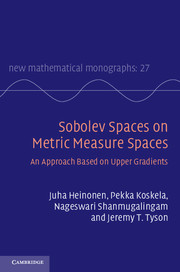Book contents
- Frontmatter
- Dedication
- Contents
- Preface
- 1 Introduction
- 2 Review of basic functional analysis
- 3 Lebesgue theory of Banach space-valued functions
- 4 Lipschitz functions and embeddings
- 5 Path integrals and modulus
- 6 Upper gradients
- 7 Sobolev spaces
- 8 Poincaré inequalities
- 9 Consequences of Poincaré inequalities
- 10 Other definitions of Sobolev-type spaces
- 11 Gromov–Hausdorff convergence and Poincaré inequalities
- 12 Self-improvement of Poincaré inequalities
- 13 An introduction to Cheeger's differentiation theory
- 14 Examples, applications, and further research directions
- References
- Notation index
- Subject index
3 - Lebesgue theory of Banach space-valued functions
Published online by Cambridge University Press: 05 February 2015
- Frontmatter
- Dedication
- Contents
- Preface
- 1 Introduction
- 2 Review of basic functional analysis
- 3 Lebesgue theory of Banach space-valued functions
- 4 Lipschitz functions and embeddings
- 5 Path integrals and modulus
- 6 Upper gradients
- 7 Sobolev spaces
- 8 Poincaré inequalities
- 9 Consequences of Poincaré inequalities
- 10 Other definitions of Sobolev-type spaces
- 11 Gromov–Hausdorff convergence and Poincaré inequalities
- 12 Self-improvement of Poincaré inequalities
- 13 An introduction to Cheeger's differentiation theory
- 14 Examples, applications, and further research directions
- References
- Notation index
- Subject index
Summary
In this chapter we review some topics in the classical Lebesgue theory for functions valued in a Banach space. We will study the basic properties of measurable vector-valued functions as defined by Bochner and Pettis. The Lp-spaces of Banach space-valued functions are introduced and studied. Along the way, we recall many fundamental notions of measure theory. It is assumed that the reader is familiar with basic Lebesgue theory for real-valued functions. (Knowledgeable readers who are only interested in the real-valued theory may proceed directly to Section 3.3.) We also define what is meant by a metric measure space in this book and discuss at some length the relationship between Borel regular measures and Radon measures in the context of metric measure spaces. Finally, we discuss covering theorems, Lebesgue differentiation theory, and maximal functions.
Measurability for Banach space-valued functions
In the first two sections of this chapter we assume that (X, μ) is a complete and σ-finite measure space and that V is a Banach space.
At this juncture, by a measure on a set X we mean a countably additive set function μ that is defined in some σ-algebra M of measurable subsets of X such that ∅ ∈ M and that takes values in [0, ∞] with μ(∅) = 0; later, in Section 3.3, we give this term a wider meaning. A measure on X is σ-finite if X admits a partition into countably many measurable sets of finite measure, and it is complete if every subset of a set of measure zero is measurable. Every measure can be completed by enlarging, if necessary, the σ-algebra of measurable sets. A function f : X →[−∞, ∞] is measurable if f−1([−∞, a)) is a measurable set for every a ∈ ℝ.
A function f : X → V is called simple if it has finite range and if the preimage of every point is a measurable set.
Information
- Type
- Chapter
- Information
- Sobolev Spaces on Metric Measure SpacesAn Approach Based on Upper Gradients, pp. 36 - 97Publisher: Cambridge University PressPrint publication year: 2015
